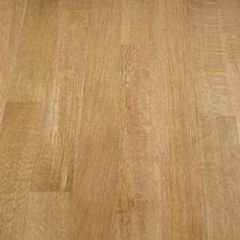Unfinished Oak Flooring
 As one of the most popular domestic hardwood species, oak flooring is durable and presents few to no installation complications. No matter if you choose red or white oak flooring for your home, both are characterized by open grain with a moderately coarse texture and high shock and wear resistance. All unfinished red or white oak flooring is graded on appearance under the following labels: Select & Better, #1 Common, Character, #2 Common, and #3 common; the higher the grade, the fewer character marks the unfinished oak hardwood has. Aside from these similarities, however, red and white oak flooring have a few notable differences.
As one of the most popular domestic hardwood species, oak flooring is durable and presents few to no installation complications. No matter if you choose red or white oak flooring for your home, both are characterized by open grain with a moderately coarse texture and high shock and wear resistance. All unfinished red or white oak flooring is graded on appearance under the following labels: Select & Better, #1 Common, Character, #2 Common, and #3 common; the higher the grade, the fewer character marks the unfinished oak hardwood has. Aside from these similarities, however, red and white oak flooring have a few notable differences.
Red oak hardwood has a moderately uniform appearance, with heartwood and sapwood both colored a light red. With a Janka scale rating of 1290, red oak hardwood is resistant to splitting, has good holding ability, and sands well. For bleaching a floor, red oak is ideal.
White oak, on the other hand, has white, cream, or light brown heartwood and sapwood. The hardwood is characterized by longer rays when plainsawn, although other cuts have minimal variation. With a Janka scale rating of 1360, white oak hardwood is slightly more dense and durable than red oak and proves to be better for machining. While bleaching the wood is not recommended, white oak has a high concentration of tannins, which allow the hardwood to be resistant to fungi and insects.
For a traditional look, unfinished oak flooring allows for more possibilities in a space. Both unfinished red and white oak flooring stain well, and once installed, small portions of the floor can be tested with various finishes in order to find the right color. To install unfinished oak flooring, however, the full area must be sterile and isolated. While installing, sanding, and finishing can take weeks, unfinished oak flooring, more so than prefinished planks, can blend in seamlessly with existing materials in your home.
